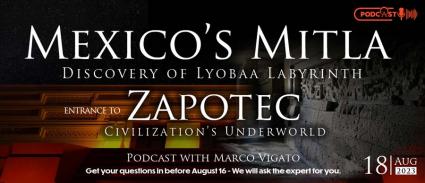
The archaeological site of Mitla, in southern Mexico, is visited every year by tens of thousands of tourists, drawn to the site by its impressive stone mosaics, ornate temples and palaces. Mitla flourished as a ceremonial center in the Postclassic period, between 900 and 1200 AD, and was with Monte Albán one of the most important centers of the ancient Zapotec civilization. Its buildings employ some of the finest stonework in all of Mesoamerica, including huge monolithic lintels and columns weighing over 25 tons each.
The importance of Mitla as a ceremonial center was directly connected to the cult of the Dead, reflected in the ancient name of the site, meaning "Place of Tombs". In 1674, father Francisco de Burgoa spoke of the subterranean labyrinth of Mitla, believed to be an entrance to the Zapotec Underworld, or Lyobaa, located under the ruins. He described a complex arrangement of four subterranean chambers, leading into a dark abyss extending thirty leagues under the ground. According to Burgoa, all entrances to this vast cavern were sealed in the late 16th century.
In 2022, a new geophysical survey by the INAH, UNAM and the ARX Project scanned the site of Mitla in search of subterranean chambers: The study revealed a set of large, interconnected cavities underneath the Church Group of the ancient site, in the same location claimed by tradition to conceal the entrance to Burgoa's underground labyrinth.
The research further demonstrated the existence of an earlier construction stage of the Palace of the Columns, Mitla's most iconic and best preserved ancient structure, which may help to push back in time the origins of this important ceremonial center.
Marco Vigato informs us about the latest findings of this important archaeological project. More research is under way to confirm the extent of the subterranean passages and identify possible access points, with a new expedition planned for September 2023.
 Marco M Vigato, a native of Italy, lives in Mexico City and has travelled extensively across Europe, the Middle East, North Africa, South-East Asia, North and South America. He is also a passionate photographer, dedicated to documenting the evidence of ancient advanced civilizations and sacred sites around the world. Much of his recent research has focused on the megalithic remains of ancient Mexico and Mesoamerica, leading him to the discovery of several little-known sites in the central Mexican highlands showing evidence of advanced engineering and architecture. He is currently working on a more comprehensive study of the origins and development of megalithic civilizations around the world, which will focus on cultural and historical aspects, as well as on the relationship of ancient megalithic sites with sacred geometry, astronomy, and geodesy. He holds an MBA from Harvard Business School and a B.A. and M.Sc. in Finance from Bocconi University. | To see more, visit : www.arxproject.org and https://donadora.org/campanas/project-lyobaa
Marco M Vigato, a native of Italy, lives in Mexico City and has travelled extensively across Europe, the Middle East, North Africa, South-East Asia, North and South America. He is also a passionate photographer, dedicated to documenting the evidence of ancient advanced civilizations and sacred sites around the world. Much of his recent research has focused on the megalithic remains of ancient Mexico and Mesoamerica, leading him to the discovery of several little-known sites in the central Mexican highlands showing evidence of advanced engineering and architecture. He is currently working on a more comprehensive study of the origins and development of megalithic civilizations around the world, which will focus on cultural and historical aspects, as well as on the relationship of ancient megalithic sites with sacred geometry, astronomy, and geodesy. He holds an MBA from Harvard Business School and a B.A. and M.Sc. in Finance from Bocconi University. | To see more, visit : www.arxproject.org and https://donadora.org/campanas/project-lyobaa
